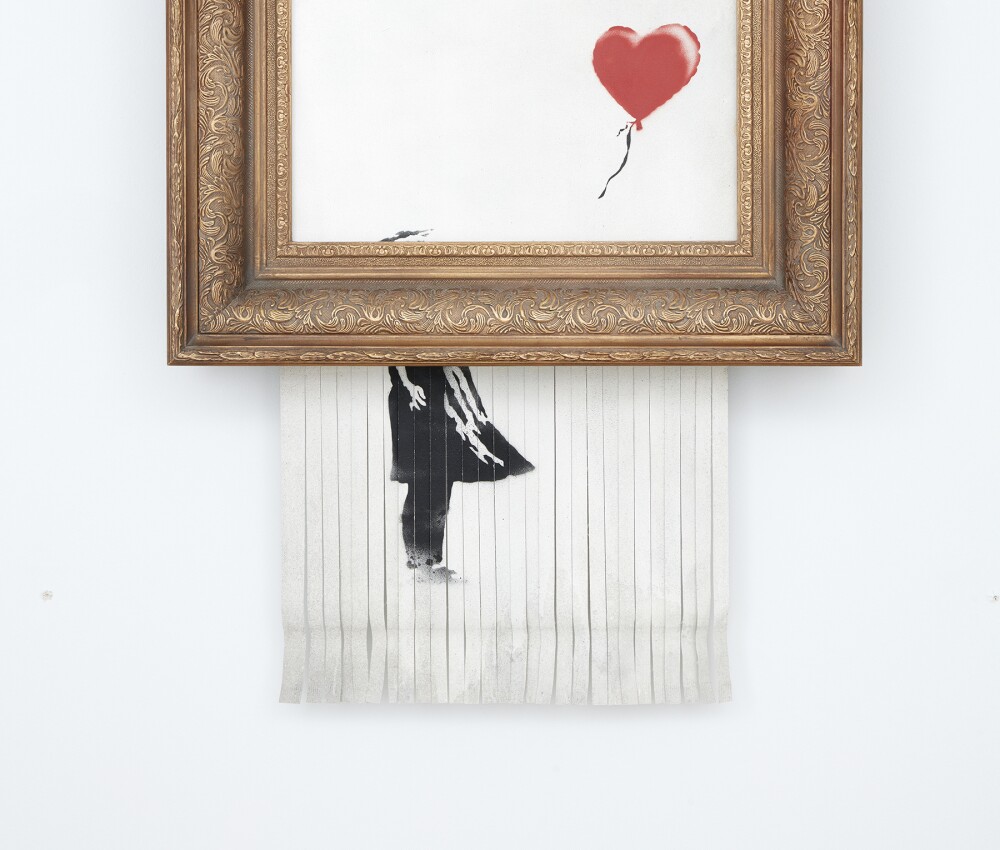In the contemporary art world, few artists wield irony and wit as masterfully—and subversively—as Harland Miller and Banksy. Though stylistically distinct, both use humor, satire, and sharp social commentary to question dominant narratives, expose hypocrisies, and provoke reflection. Their works operate as visual Trojan horses: accessible, often humorous at first glance, but deeply layered with critique. By tapping into the cultural zeitgeist with a distinctly British sensibility, Miller and Banksy challenge the viewer to confront uncomfortable truths about society, identity, and power.

Harland Miller: Literary Irony and Existential Mockery
Harland Miller’s artistic practice is rooted in language. Best known for his large-scale paintings of reimagined Penguin book covers, Miller fuses the aesthetics of mid-20th-century publishing with razor-sharp textual subversion. These faux titles—such as “Happiness: The Case Against” or “I’ll Never Forget What I Can’t Remember”—mirror the format of self-help books or existential novels while deliberately undermining their authority. With dry British humor, Miller distorts the comforting nostalgia of book culture to highlight modern anxieties, absurdities, and contradictions.
Irony functions in Miller’s work as a tool of emotional and cultural excavation. The familiar, battered Penguin covers evoke memories of a more literate, idealistic time, yet the absurdist titles deflate any illusion of security or resolution. His paintings often read like the punchline to an intellectual joke—but the kind that leaves a sting. By referencing the language of therapy, self-improvement, and middlebrow literature, Miller exposes the failure of these systems to provide real answers in a fractured world. In this way, his irony doesn’t simply amuse; it confronts.

Miller’s wit is also deeply personal. Many titles reflect an inner dialogue of insecurity, failure, or sardonic wisdom. His texts serve as commentaries on the human condition, suggesting that beneath every social veneer lies an existential crisis or emotional hang-up. The works laugh with us—but also at us.
Banksy: Guerrilla Humor and Institutional Critique
Banksy’s subversive power lies in his anonymity, street-level accessibility, and sharp visual storytelling. Where Miller dissects culture with a literary scalpel, Banksy delivers his critique like a Molotov cocktail. His wit is more direct, often blending visual puns with biting political commentary. Whether it’s a protestor hurling a bouquet of flowers or a riot policeman skipping with a smile, Banksy’s humor operates in stark juxtaposition to the imagery’s usual context.

Irony is fundamental to Banksy’s mode of disruption. He often inserts symbols of innocence—children, balloons, cartoon characters—into scenes of oppression or violence. The contrast generates both emotional dissonance and critical reflection. By flipping familiar images, he calls attention to the normalization of systemic injustice, capitalism’s absurdities, or the banality of war. The simplicity of the visuals makes the message all the more devastating.
Banksy also exploits the art world’s own contradictions. His works routinely mock the commodification of art even as they break auction records. In doing so, Banksy turns the mirror on collectors and institutions, daring them to grapple with their complicity. A prime example is his 2018 piece “Love is in the Bin”—a self-destructing artwork that shredded itself the moment it was sold at Sotheby’s. The stunt exposed the absurdity of market fetishism and turned the piece into an even more valuable meta-commentary.

Irony as Subversion: Points of Convergence
What unites Miller and Banksy is their use of irony not just as a stylistic flourish but as a strategic act of rebellion. Their wit isn’t decorative; it’s weaponized. They employ humor to unseat norms, question power, and make viewers complicit in the contradictions they critique.
Both artists also rely heavily on context. Miller’s works are typically shown in white-cube gallery settings, where their deadpan text and nostalgic design become critiques of cultural elitism and introspective malaise. Banksy, on the other hand, thrives on placement—his stencils appear in alleyways, borders, and politically charged landscapes. Location becomes part of the joke and the message.
Despite their differences, both artists succeed in making subversion palatable—and therefore more potent. Their works are easy to engage with, hard to forget, and impossible to ignore.
In an age oversaturated with images and competing narratives, irony has become one of the last tools of honest critique. Harland Miller and Banksy exemplify how humor can disarm, engage, and ultimately unsettle. Their works don’t preach—they provoke. And in doing so, they grant the viewer just enough laughter to lower their defenses before delivering a gut punch of truth.
Whether on a gallery wall or a city street, Miller and Banksy remind us that art need not be solemn to be serious. With wit as their weapon and irony as their shield, they carve out a space for meaningful dissent in a world that desperately needs it.
Discover Banksy prints for sale or if you are looking to buy Harland Miller art,contact our New York and London galleries for further information.


